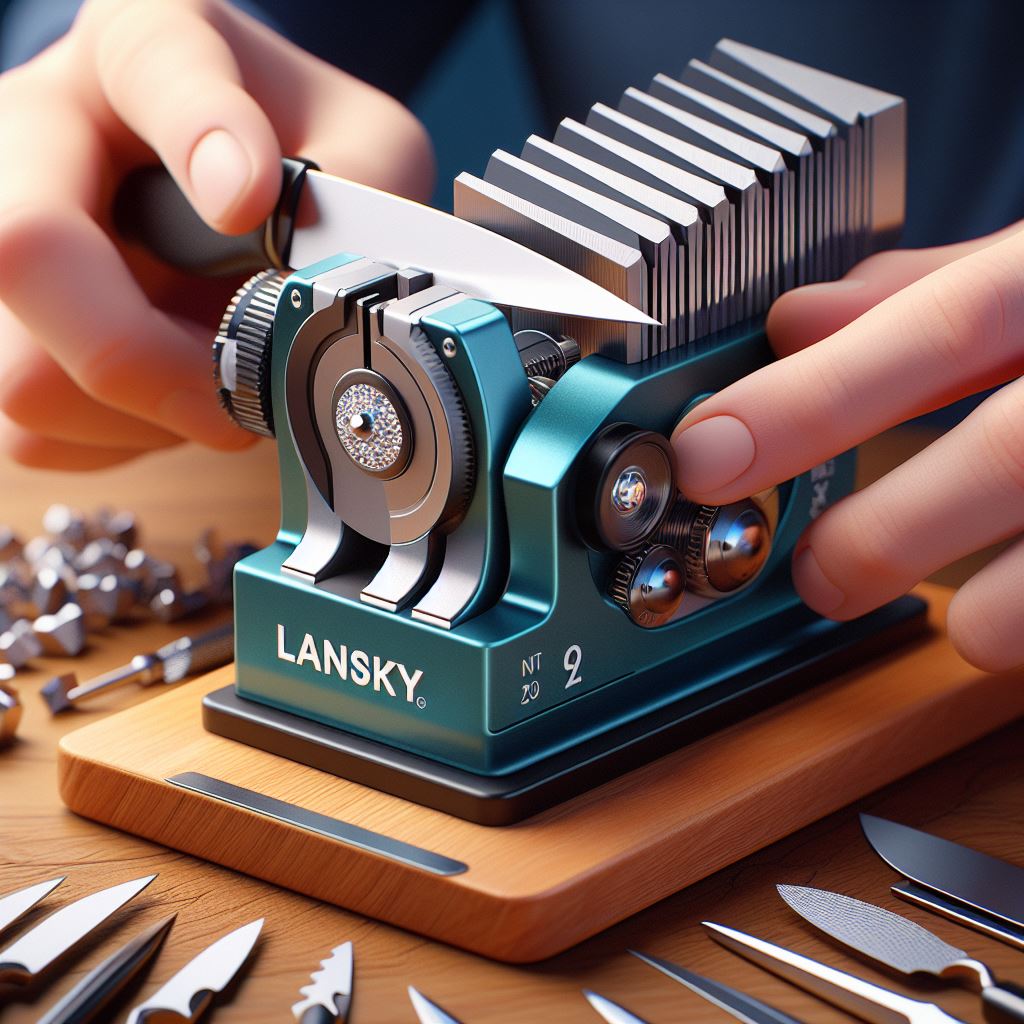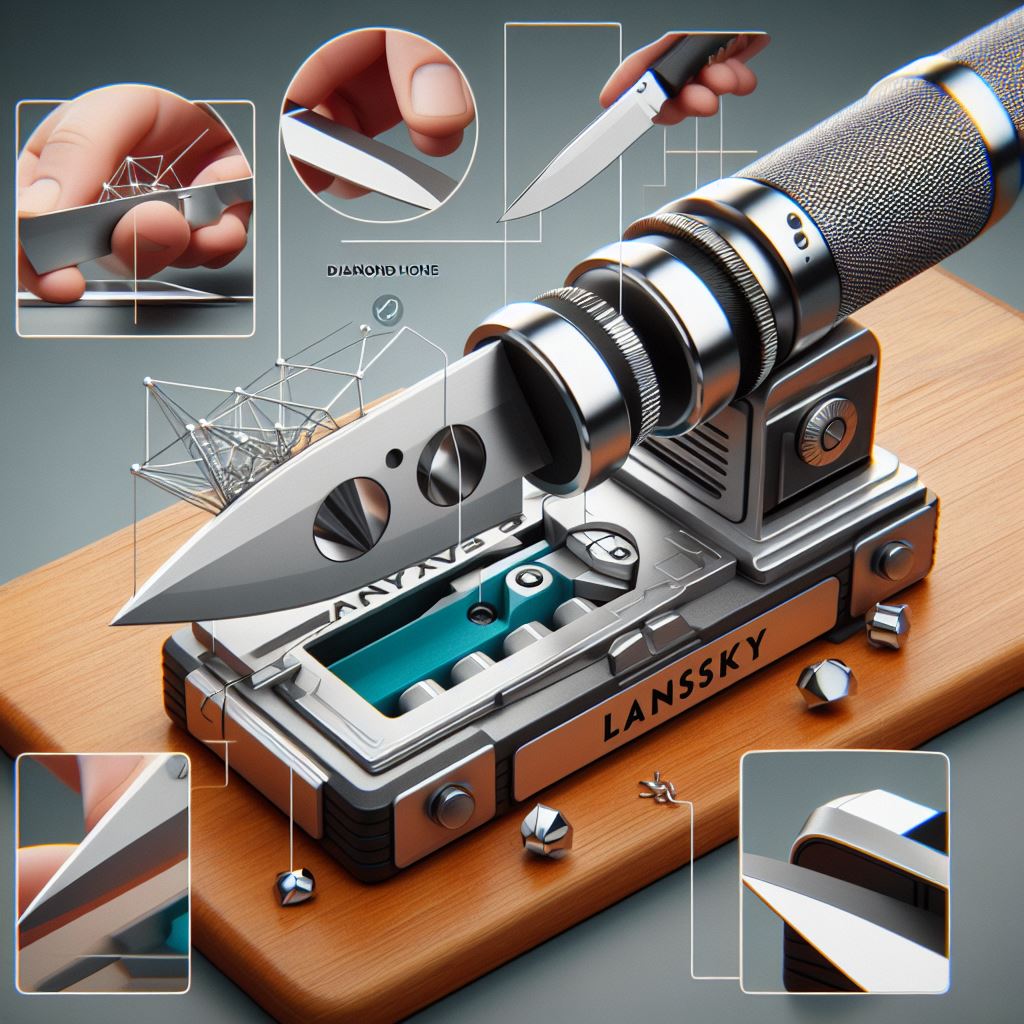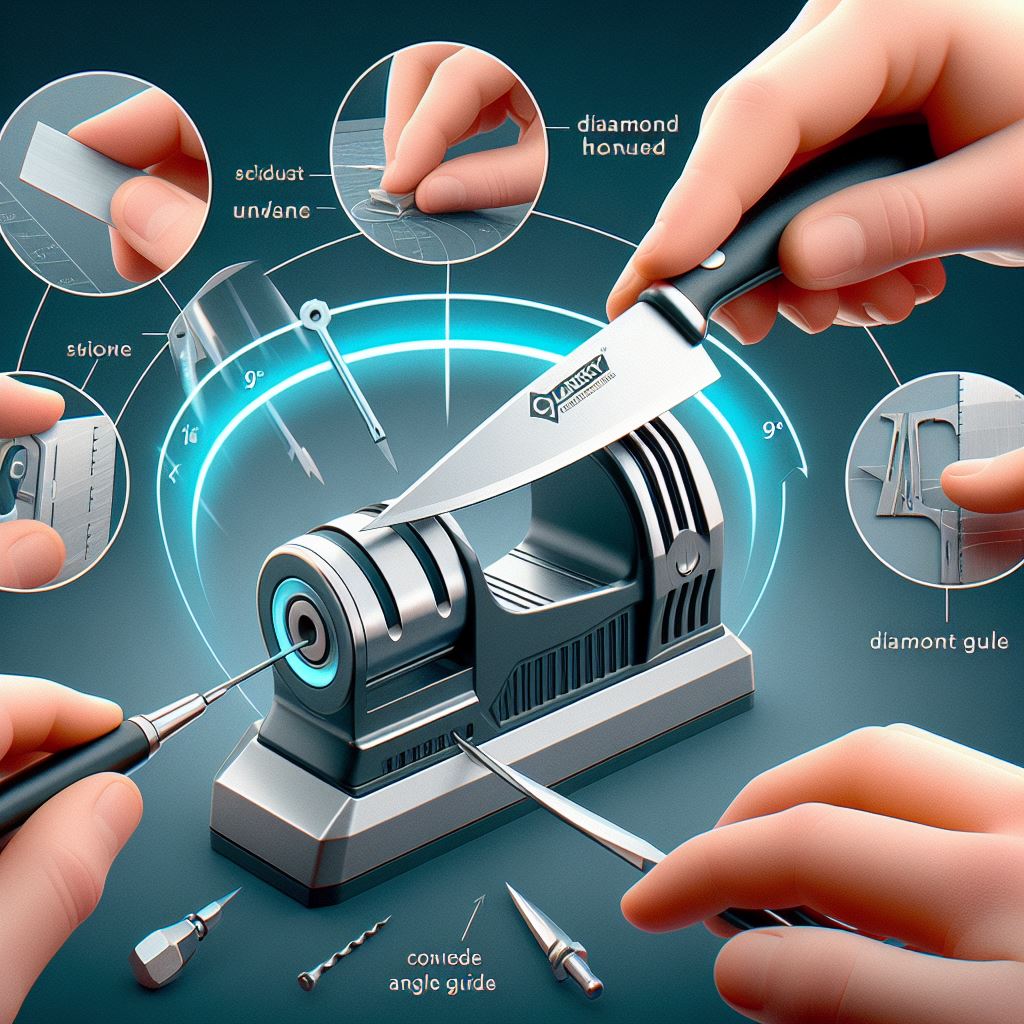To use a Lansky Knife Sharpener, clamp your blade and stroke the sharpener across its edge. Select the appropriate angle for your knife and maintain consistent strokes for best results.
Sharpening knives is essential for maintaining their performance and safety. The Lansky Knife Sharpener stands out for its precision and ease of use, appealing to both culinary enthusiasts and professionals seeking to keep their blades in top condition. This compact system offers a variety of grits for custom sharpening, with a clamp and guide rods ensuring a consistent angle.
The process not only extends the life of your knives but also enhances your cutting precision. Embracing the methodical approach of the Lansky Sharpener can transform a dull blade into one that cuts with exceptional ease—the key to a seamless kitchen experience.

Introduction To Knife Sharpening
The cornerstone of culinary prowess and outdoor survival skills often boils down to one critical tool – the knife. Whether you’re dicing vegetables, carving wood, or filleting fish, the sharpness of your blade can be the line between frustration and finesse. Knife sharpening is not just a skill, it’s an art form, enabling you to maintain the integrity and efficacy of your most trusted utensil. To ensure durability and longevity of your knife, proper care and routine maintenance are paramount.
The Basics Of Knife Care And Maintenance
Ensuring your knife’s optimum performance involves more than just occasional sharpening. Here’s a quick overview of essential knife care and maintenance:
- Clean knives after each use to prevent residue build-up.
- Use the appropriate cutting board (wood or plastic is ideal) to reduce blade dulling.
- Store your knife in a safe, dry place; consider a knife block or magnetic strip.
- Regularly hone your knife to realign the blade’s edge.
- Professionally sharpen or use a reliable sharpening system when the blade dulls.
Understanding The Lansky Knife Sharpening System
One standout solution to keeping your blades at their sharpest is the Lansky Knife Sharpening System. Renowned for precision, it utilizes a series of hones with varying grits to help you achieve the desired edge. Different angles are attainable through the system’s clever design, ensuring an accurate bevel throughout the sharpening process. Here is condensed insight into this system:
| Component | Function |
|---|---|
| Clamp | Secures the knife and maintains angle consistency |
| Hones | Come in various grits for different sharpening stages |
| Guide Rods | Attach to hones and guide the sharpening process |
| Angle Bracket | Allows adjustment of sharpening angle to fit the knife’s original edge |
The Lansky system democratizes the sharpening experience, letting both beginners and pros achieve razor-sharp edges with minimal guesswork and maximal precision. Consistency in angle maintenance and versatility in honing options make this tool a superb choice for maintaining your knives’ longevity and performance.
Setting Up Your Lansky Knife Sharpener
Perfectly sharpened knives are a chef’s best friend, and a Lansky Knife Sharpener is a tool that promises precision and effectiveness. Setting up your Lansky Sharpener is straightforward; follow these steps to ensure your knives achieve a blade worthy of the finest cutlery. Each stage is crucial for achieving the sharpest edge.
Identifying The Correct Sharpening Angle
Selecting the right angle for sharpening your knife is paramount to the honing process. The Lansky system provides multiple angle options ranging from 17 to 30 degrees, catering to different knife designs and purposes.
- 17° Angle: Ideal for razor blades, fillet knives, or similar tools that require a razor-sharp edge.
- 20° Angle: Great for kitchen cutlery and slicing knives that need a sharp edge for precise cuts.
- 25° Angle: The go-to for hunting and outdoor knives, balancing sharpness with durability.
- 30° Angle: Reserved for heavy-duty knives such as those used for chopping or splitting wood.
Take your knife’s purpose and blade type into consideration to choose the appropriate sharpening angle for optimal results.
Assembling The Lansky Clamp And Guide Rods
The Lansky Clamp and Guide Rods are essential for maintaining consistent sharpening angles. Proper assembly is crucial.
- Clean your knife blade and secure it tightly within the clamp. Make sure the blade is centered and the clamp screws are tightened for stability and safety.
- Insert the guide rods into the holes corresponding with your desired sharpening angle on the hones.
- Ensure each rod is firmly in place and the angle alignment is consistent across the different hones you plan to use.
With the clamp and guide rods assembled, you’re ready to commence sharpening with precision.
Choosing The Right Hone For Your Knife
The Lansky system offers a variety of hones, each designed for different sharpening stages. Choosing the correct hone is like picking the right tool for a job – it’s essential for achieving the desired edge on your blade.
| Hone Type | Use |
|---|---|
| Extra Coarse | Repairing chips or for re-profiling an edge. |
| Coarse | Initial sharpening of dull blades. |
| Medium | Basic sharpening and edge maintenance. |
| Fine | Refining and polishing the blade edge for sharpness. |
| Ultra Fine | For razor-sharp edges and final polish. |
Assess your knife’s current condition and select the hone that matches the sharpening stage you’re at. Gradually work your way through finer hones to achieve that exquisite sharpness.
A dull blade is a frustration no chef or outdoorsman wants to endure. Understanding how to skillfully use a Lansky Knife Sharpener could be the game-changer you need. Renowned for precision, the Lansky System provides a straightforward method to achieve the perfect edge. Whether tackling a prized kitchen knife or a reliable camping tool, mastering the Lansky Sharpener enriches the cutting experience.
Step-by-step Guide To Sharpening
Let’s walk through the sharpening process to transform your blunted blade into a cutting marvel:
- Clamp Your Knife – Secure the knife with the edge facing up in the clamp provided. Ensure it’s tight to avoid movement during the sharpening process.
- Choose Your Angle – Select the angle that fits your blade’s original bevel or desired sharpness—17° for a razor-sharp edge to 30° for a durable edge.
- Insert the Hone – Slide your coarsest hone into the guide rod and adjust the rod to match your selected angle.
- Apply Sharpening Oil – A few drops on the hone prevent metal shavings from clogging the stone.
- Sharpen the Blade – Glide the hone along the blade from heel to tip with even, controlled strokes.
- Repeat – Maintain the same angle and switch sides after equal strokes to ensure an evenly sharpened edge.
- Clean the Blade – Once sharpened, wipe the knife to remove any residue.
Tips For Maintaining Consistent Stroke Pressure
Maintaining consistent stroke pressure is vital for sharpening:
- Start Light – Begin with gentle pressure and increase as needed, focusing on maintaining the same level throughout.
- Consistent Angles – Use the Lansky System angles as a guide to keep your strokes stable and consistent.
- Count Your Strokes – Keep a balanced sharpening by counting the number of strokes used on each side of the blade.
How To Progress Through Different Hone Grades
Moving through hone grades is seamless with these steps:
- Coarse Hone – Starting with the coarse stone, set the groundwork for the edge.
- Medium Hone – Transition to a medium hone to refine the edge further.
- Fine Hone – Conclude with a fine hone for a polished, razor-sharp finish.
- Final Strokes – Finish with a few light passes to remove any burrs or imperfections.
Patience and progression through the honing grades ensure a sharp, durable edge that can handle any task.
Sharpening Your Knife With The Lansky System

Finishing Touches And Knife Care Post-sharpening
Achieving a sharp blade is only part of the knife maintenance journey. Post-sharpening care is crucial for preserving the knife’s edge and extending its life. Below is a comprehensive guide to giving your knife the finishing touches using a Lansky Knife Sharpener and the essential care tips to maintain its condition.
Polishing The Knife Edge For Optimal Sharpness
Once the sharpening process is complete, polishing the edge can remove any microscopic burrs and refine the blade to its optimal sharpness.
- Attach the ultra-fine hone to your Lansky system.
- Apply a few drops of honing oil to the stone.
- Glide the hone along the edge of the blade in smooth, even strokes.
- Repeat on both sides of the knife until you achieve a mirror-like finish.
- Wipe the blade with a clean cloth to remove any residual oil or metal filings.
Cleaning And Storing Your Lansky Knife Sharpener
Proper maintenance of your Lansky Sharpener will ensure its longevity and readiness for future use. Follow these steps to clean and store your sharpener:
- Clean any metal shavings off the stones with a soft brush or cloth.
- Lightly oil the hones to prevent corrosion, especially if storing for extended periods.
- Organize the components in the Lansky storage case, keeping them dry and organized.
Maintaining Your Knife After Sharpening
After sharpening and polishing, proper knife care is crucial for preserving its cutting performance:
| Maintenance Task | Details |
|---|---|
| Cleaning: | Wipe your knife after each use with a damp cloth and dry immediately. |
| Oil the Blade: | Occasionally apply a light coat of oil to protect the steel from moisture. |
| Store Properly: | Place your knife in a dry environment, away from extreme temperatures or humidity. |
| Regular Inspections: | Periodically check for signs of wear or damage that may impact performance. |
Conclusion
Sharpening your knives with a Lansky Sharpener is a smart move. This guide has shown you the steps to achieve the perfect edge. Remember, regular maintenance ensures longevity and safety. Start honing your skills and slice with precision every time.
Happy sharpening!
Frequently Asked Questions On How To Use A Lansky Knife Sharpener
What Is A Lansky Knife Sharpener?
A Lansky Knife Sharpener is a precision sharpening kit designed for maintaining a razor-sharp edge on various types of knives. Its controlled-angle sharpening system ensures consistency and optimal results.
How Does The Lansky Sharpener Work?
The Lansky Sharpener uses a series of stones attached to guide rods set at predetermined angles. By holding the knife stationary and stroking the stone across the blade, you can sharpen to a precise edge.
Can You Sharpen Serrated Knives With Lansky?
Yes, Lansky knife sharpeners can also handle serrated knives. Specific serrated sharpening hones are designed to get into the grooves and sharpen effectively.
What Angles Can I Sharpen With Lansky?
Lansky sharpeners offer multiple angle options, typically ranging from 17 to 30 degrees, to cater to different types of knives and desired sharpness.







